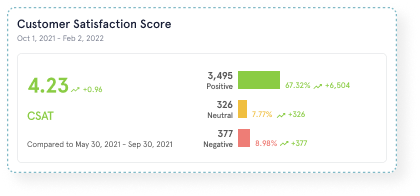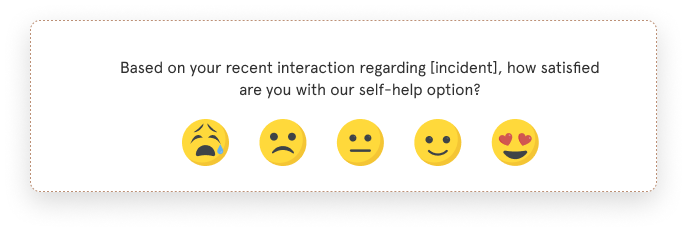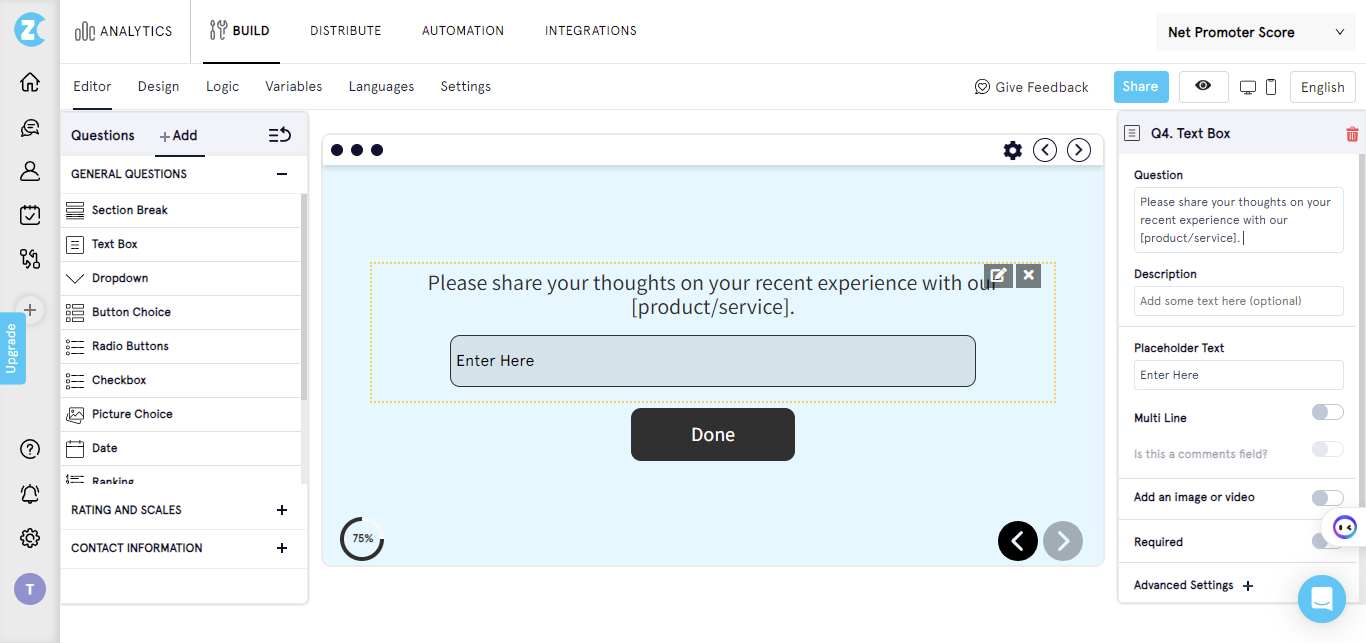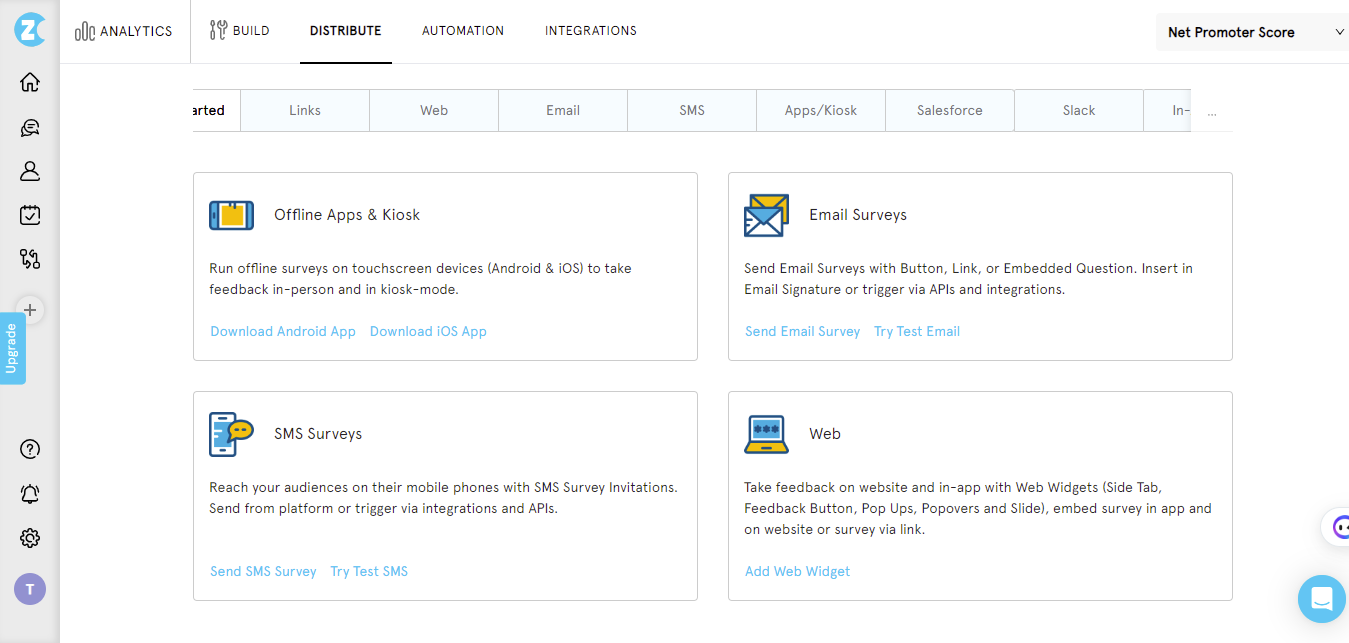What do your customers really think of you?
It’s a simple question—with a surprisingly complex answer.
You may be tracking NPS scores, reading open-text survey responses, maybe even monitoring online reviews. But if you’ve ever sat with all that data and still felt unsure about how your customers truly feel, you’re not alone. Most businesses are drowning in feedback but starving for insight.
The real challenge isn’t collecting feedback—it’s interpreting the sentiment behind it. The polite comment masking dissatisfaction. The enthusiastic tone that signals advocacy. These emotional cues hold the key to understanding customer experience at a deeper level.
That’s where sentiment analysis comes in.
When applied effectively, it unlocks the emotional layer of customer feedback—giving you the clarity to know what’s working, what’s not, and why. It transforms scattered responses into strategic insight, helping you prioritize, respond faster, and ultimately, drive better outcomes across the board.
In this blog, we’ll break down what sentiment analysis really is, how it works behind the scenes, and how it turns raw feedback into real-time clarity. But what exactly, is sentiment analysis, and more importantly, how it can boost customer experiences?
TL;DR
- Customer sentiment analysis enables businesses to understand their customer's thoughts.
- Sentiment analysis, powered by technologies like NLP and machine learning, decodes customer emotions from various sources like customer feedback, reviews, and social media. It's not just about positive or negative; it delves into nuances.
- It transforms customer service, helps identify pain points, and allows personalized interactions.
- You can perform sentiment analysis through various approaches. From emotion analysis to multilingual analysis. It's not just about analyzing sentiments; it's about crafting a better customer journey and staying ahead of trends.
- Survey software becomes a potent tool, collecting and analyzing data, offering real-time insights, and paving the way for actionable improvements.
- Zonka Feedback is a powerful survey tool that comes with sentiment analytics to decipher hidden insights from the feedback received. You can sign up for a schedule a demo to learn more about this tool.
Measure Customer Feedback & Insights
With feedback surveys, understand what users need and learn ways to delight your customers.

What is Sentiment Analysis?
From happy to sad, from disappointed to delighted, from agitated to satisfied, customers display an array of emotions and sentiments while interacting with a brand. And all of these emotions, combined, reflect upon your brand's customer experience.
In simple words, sentiment analysis is the technique used for identifying human emotions or sentiments behind the words they use. The process includes analyzing text data input by customers and finding out whether they are happy/positive, unhappy/negative, or neutral/passive.
Online, customers leave their thoughts in many different places. This could be through reviews, emails, and social media. Customer sentiment analytics software analyzes these messages to understand the emotions being expressed. Does a customer display positive, negative, or neutral emotions?

Sentiment analysis tools make use of a technique called natural language processing (NLP). This is a subset of machine learning designed to replicate the way humans interpret language. Some advanced models use a numerical scale (such as -1 to 1 or -100 to 100) to represent the intensity of sentiment, though this scale varies by tool. On numerical scales, lower values represent negative sentiment, higher values indicate positive sentiment, and values near zero are interpreted as neutral.
In context to customer feedback, sentiment analysis helps analyze the context, emotions, and sentiments of customers based on the feedback that they share.
Importance of Sentiment Analysis in Improving Customer Experience
Sentiment analysis plays a vital role in enhancing the overall customer experience. It acts as a filter—separating surface-level opinions from the emotional truth beneath. It’s not just about whether your customers are satisfied. It’s about how they feel, why they feel that way, and what you can do about it in real time.
Here are some key reasons why sentiment analysis is crucial for improving customer experience:
1. Better Service Outcomes and Customer Experience
The best part about sentiment analysis is that it provides real-time insights into how customers perceive the brand, its services, and interactions. Not only does it disclose the surface level of the feedback but also gives an understanding of the customer's sentiments and emotions while interacting.
By identifying positive or negative emotions through sentiment analysis, businesses can take proactive measures to address any issues or concerns, resulting in better service outcomes and an improved overall customer experience. They can adjust service strategies, product experience, and more based on how customers are reacting.
2. Capture the Full Emotional Landscape
Sentiment analysis gives you more than just a label—it offers a complete emotional snapshot of your customer experience. By analyzing feedback across channels (surveys, reviews, chats, and support tickets), it uncovers the underlying mood, tone, and attitude behind every comment.
This means you don’t just know what customers are saying—you understand how they feel while saying it. Whether it’s quiet frustration in a support ticket or enthusiastic praise in a review, sentiment analysis decodes these emotional signals so you can respond with empathy, adjust your messaging, and personalize interactions at scale. The result? A deeper, more human understanding of your customers, and smarter strategies built on emotional clarity.
3. Enhance Customer Satisfaction based on Data-driven Actions
By analyzing customer sentiments, businesses gain valuable insights into the areas where they can improve and take data-driven actions to enhance customer satisfaction. Sentiment analysis serves as a guiding compass for businesses, allowing them to prioritize their efforts and allocate resources where they are most needed.
This approach of having customer satisfaction surveys to gauge feedback and sentiments leads to more efficient and effective customer service. It lets businesses focus on addressing the pain points that have the greatest impact on customer satisfaction.

4. Identify Customer Pain Points
Sentiment analysis helps businesses identify common pain points and issues faced by customers. By analyzing feedback and sentiments related to specific aspects, features, touchpoints, or stages in the journey of a product or service, businesses can pinpoint areas for improvement. This enables them to address customer concerns and enhance the overall customer experience.
By understanding the emotions behind customer feedback, you can pinpoint exactly where things might be going wrong. Whether it's a glitch in the system, a confusing process, or a feature that's more frustrating than helpful, sentiment analysis can highlight those pain points so you can smooth them out.
5. Offer Personalized Interaction
Sentiment analysis adds a personal touch to customer interactions by allowing businesses to tune in to the emotional vibes of their customers. It's like having a sixth sense that helps you respond not just to what customers say, but how they feel.
Sentiment analysis enables businesses to personalize their interactions with customers based on their sentiments. By tailoring responses and support according to the emotions expressed, businesses can create a more engaging and satisfying customer experience. It helps businesses speak the emotional language of their customers. It's not just about solving problems; it's about connecting on a human level.
Personalizing interactions based on sentiments builds a stronger bond between the customer and the brand, making the overall experience more memorable and satisfying.
6. Strategize Market Positioning through Informed Insights
Knowing where to position your product in the market is key to success. Making an informed decision, though, isn’t easy, and any misjudgment can sink your business. Luckily, constant monitoring of customer sentiment can give you the insights you need.
Not only will you get a better understanding of the features that customers would like to see in your products, but based on sentiment from different platforms, you can pick the best place to market your product.
7. Identify Churn Risks to Boost Retention
Sentiment analysis helps businesses identify customers who are at risk of churning. By analyzing the sentiments expressed in customer feedback, businesses can proactively address any issues or concerns and take measures to retain valuable customers.
Imagine a customer expressing frustration or disappointment consistently in their interactions with your brand. Sentiment analysis flags this as a potential churn risk. Instead of waiting for a customer to outright say, "I'm leaving," you can identify signs of dissatisfaction early on.
By monitoring sentiments, businesses can proactively address issues before they escalate. If a customer is unhappy, you can swoop in with personalized solutions, discounts, or even just a heartfelt apology.
This proactive approach not only resolves the immediate problem but also signals to the customer that their concerns are valued, potentially turning a disgruntled customer into a loyal one.
8. Strengthen Core CX Metrics with Emotional Insight
Sentiment analysis doesn’t just help you understand customers—it makes your CX metrics work harder. Emotional language in open-ended question responses often reveal what traditional scores alone can’t. Negative sentiment in survey comments frequently ties back to NPS Detractors, even if they don’t explicitly say they’re dissatisfied. Similarly, positive tone in agent-related feedback is a strong indicator of high CSAT, while frustration-laced phrases signal a poor CES, often pointing to complex, effort-heavy interactions.
By layering sentiment analysis onto your CX program, you gain a deeper understanding of what's driving each metric—helping you move from superficial scores to root-cause clarity.
💡With Zonka's AI Feedback Intelligence, the emotional signals in customer experience data are automatically detected and contextualized. Powered by GenAI, NLP, and urgency detection, it analyzes feedback across multiple channels to uncover not just sentiment—but underlying emotions, intent, and priority. Whether it’s disappointment in a product feature or appreciation for support, each comment is tagged to the right themes, people, or touchpoints—offering immediate clarity on what’s influencing your CX performance and where to take action.
Types of Sentiment Analysis
Understanding the different types of sentiment analysis is crucial to extracting actionable insights from customer feedback. While many businesses focus on overall sentiment—positive or negative—the real value comes from digging deeper into how intensely customers feel, what specific parts of their experience trigger those feelings, and how emotions influence behavior.
Here are the major types of sentiment analysis used in customer feedback interpretation:
1. Binary Sentiment Analysis
Binary sentiment analysis classifies feedback into simple positive or negative categories—no middle ground. It’s a fast way to scan the emotional tone of customer feedback at scale. For instance,
“Love the new dashboard!” → Positive
“This latest update broke everything.” → Negative
Why it matters: Binary sentiment is useful for high-level trend analysis and quick classification, especially for large datasets like reviews or survey comments.
2. Fine-Grained Sentiment Analysis
Fine-grained sentiment analysis goes deeper than just good or bad—this approach captures sentiment intensity like “very positive” or “slightly negative.” It’s especially useful for interpreting survey scales or layered feedback. For instance,
“It’s okay, not what I expected.” → Mildly negative
“This is hands down the best update yet!” → Strongly positive
Why it matters: Helps you detect subtle shifts in sentiment before they escalate into churn—ideal for roadmap prioritization and satisfaction tracking.
3. Aspect-Based Sentiment Analysis
Aspect-based sentiment analysis identifies sentiment tied to specific features, topics, or service elements. It breaks down feedback into sentiment-rich fragments. For instance,
“I love the product features, but the billing process is a nightmare.”
→ Positive: Product Features | Negative: Billing
Why it matters: Allows product and operations teams to pinpoint exactly what’s working or broken, so they can act with precision.
4. Emotion Detection
This form of analysis doesn’t just label sentiment—it identifies specific emotions like anger, joy, sadness, or surprise behind the feedback. For instance,
“I’m beyond frustrated—this issue keeps happening!” → Emotion: Anger
“Your team really made my day. So grateful!” → Emotion: Gratitude
Why it matters: Emotion detection helps brands prioritize responses and escalate emotionally charged cases faster, improving customer recovery and experience.
5. Multilingual Sentiment Analysis
Multilingual sentiment analysis helps you understand sentiment in feedback written in multiple languages—no matter where your customers are or what language they use. For instance,
“Servicio excelente, como siempre.” → “Excellent service, as always.” → Positive
Why it matters: For global businesses, multilingual sentiment analysis ensures that feedback isn’t lost in translation—and that emotional intent is preserved across geographies.
6. Graded Sentiment Analysis
Graded sentiment analysis assigns a numerical customer sentiment score to each piece of feedback—like -1 to +1 or -100 to +100—indicating sentiment strength and polarity. For instance,
Score of -0.8 → Strongly Negative
Score of +0.6 → Moderately Positive
Why it matters: Translates qualitative emotion into quantifiable data, enabling you to track sentiment trends, build benchmarks, and measure impact over time.
7. Multiclass Sentiment Analysis
A subtype of fine-grained analysis, this technique sorts feedback into multiple sentiment levels—positive, neutral, negative, and everything in between. For instance,
“Decent product, could be better.” → Neutral
“Amazing price but the delivery took forever.” → Mixed
Why it matters: Offers a balanced, nuanced view—great for measuring middle-ground sentiment and understanding customer ambivalence or dual feelings. This is especially useful for scenarios where a nuanced understanding of sentiments is required, such as categorizing feedback collected from a 1 to 5 rating survey or a 1 to 7 rating scale survey into strongly positive, mildly positive, neutral, mildly negative, and strongly negative.
Use Cases of Sentiment Analysis in Improving Customer Experience
There are several instances when customer sentiment analysis helps businesses boost their overall customer experience. By leveraging sentiment analysis tools and techniques, businesses can gain valuable insights into customer emotions and perceptions, allowing them to make informed decisions and take appropriate actions to enhance the customer journey.
1. Proactive Issue Resolution
Sentiment analysis is a powerful tool that allows businesses to identify negative sentiments in customer feedback with ease. By analyzing customer sentiments, businesses can proactively address issues, resolve complaints, and mitigate potential escalations before they impact a larger portion of the customer base.
When any negative sentiment is detected, businesses can take immediate action to rectify the situation and provide a satisfactory resolution. This proactive approach not only prevents further dissatisfaction among customers but also helps in building trust and loyalty.
Furthermore, by using sentiment analysis to identify negative sentiments, businesses can uncover patterns or common issues that may be affecting multiple customers. This allows them to implement systemic changes or improvements to their products or services, resulting in an enhanced customer experience overall.
2. Enhanced Customer Service
Real-time sentiment analysis is a game-changer for customer service teams. By identifying sentiments in customer interactions, businesses can provide personalized and empathetic support that truly resonates with their customers. When positive sentiments are detected, customer service representatives have the opportunity to acknowledge and reinforce them, further enhancing the customer experience.
With real-time sentiment analysis, customer service teams can tailor their responses based on the emotions expressed by customers. Whether a customer is frustrated, delighted, or somewhere in between, the team can adjust their tone and approach accordingly. This level of personalization allows businesses to build stronger relationships with their customers and foster a sense of trust and loyalty.

Furthermore, real-time sentiment analysis enables customer service teams to address potential issues before they escalate. By promptly identifying negative sentiments, teams can take immediate action to rectify the situation and provide a satisfactory resolution. This proactive approach not only prevents further dissatisfaction among customers but also helps in building trust and loyalty.
3. Brand Reputation Management
By leveraging sentiment analysis tools, businesses can effectively monitor online mentions and reviews related to their brand. This includes tracking social media posts, customer reviews on websites, and even comments on blog posts or articles. The sentiment analysis algorithms analyze the language and tone used in these mentions and reviews to determine whether they are positive, negative, or neutral.
Addressing negative sentiments promptly is crucial for reputation management. When customers express dissatisfaction or disappointment online, it can quickly spread and influence others' opinions of the brand. By responding strategically to these negative sentiments, businesses can not only address the concerns of the individual customer but also demonstrate their commitment to customer satisfaction to a wider audience.
Strategically responding to negative sentiments also provides an opportunity for businesses to turn a negative experience into a positive one. By acknowledging the customer's concerns and offering a solution or apology, businesses can show their dedication to resolving issues and building customer trust. This proactive approach not only helps in managing the immediate reputation risk but also contributes to long-term brand loyalty.
4. Continuous Product & Service Improvement
Organizations can identify areas for improvement, gather insights for product development, and prioritize enhancements based on customer sentiments.
Sentiment analysis provides organizations with a valuable tool for continuous improvement. By analyzing customer feedback, businesses can uncover common themes and trends that emerge from their sentiment analysis. These themes can be related to product features, customer service surveys and their interactions, or overall customer satisfaction.
Identifying these common themes allows organizations to pinpoint areas for improvement in their products or services. For example, if customers consistently express dissatisfaction with a specific feature, businesses can prioritize enhancements or updates to address these concerns. By listening to customer sentiments, organizations can gather insights that inform their product development roadmap and ensure that their offerings align with customer expectations and preferences.
5. Efficient Resource Allocation
Businesses can allocate resources efficiently by prioritizing actions based on the sentiments expressed. Focus on addressing critical issues and allocating resources where they are most needed.
Efficient resource allocation is crucial for effective business management. By using sentiment analysis to categorize feedback based on urgency and importance, businesses can optimize their resource allocation. This allows them to prioritize actions based on customer sentiments, addressing critical issues promptly and allocating resources where needed.
Sentiment analysis also helps businesses allocate resources strategically for enhancing customer experience, such as investing in training for customer service representatives or improving product features.
6. Customer Journey Optimization
Organizations can optimize the customer journey by identifying pain points and positive experiences. This leads to a more seamless and satisfying customer experience.
At each touchpoint, sentiment analysis can be applied to analyze customer feedback and interactions, providing organizations with a comprehensive understanding of the customer's sentiment throughout their journey.
For example, let's consider a scenario where a customer is browsing an e-commerce website and encounters difficulties in finding the desired product.
By using voice of customer tools that analyze customer sentiments, organizations can identify pain points and frustrations, allowing them to improve the website's user interface, search functionality, and product categorization for a better browsing experience.
Similarly, sentiment analysis can be applied to other touchpoints in the customer journey, such as the checkout process, customer support interactions, or post-purchase follow-ups. By continuously monitoring sentiments at these touchpoints, organizations can proactively address any issues or concerns, providing timely and personalized solutions to enhance the customer experience.
7. Forecasting Customer Trends
By identifying evolving customer preferences, businesses can forecast trends and align their strategies with changing market dynamics.
By analyzing the sentiments expressed by customers in their feedback, businesses can gain valuable insights into evolving customer preferences. Sentiment analysis algorithms can identify patterns and trends in the language, tone, and context of customer feedback, providing businesses with a comprehensive understanding of the shifting market dynamics.
For example, sentiment analysis may reveal a growing sentiment towards eco-friendly products and sustainability.
By detecting this emerging trend, businesses can proactively adjust their product offerings and marketing strategies to cater to the increasing demand for environmentally conscious options. This could involve developing new sustainable product lines, incorporating eco-friendly materials, or promoting green initiatives.
Furthermore, sentiment analysis can also uncover emerging trends in customer expectations and experiences. For instance, if a significant number of customers express dissatisfaction with the speed of customer service responses, businesses can anticipate a growing demand for faster and more efficient support. Armed with this knowledge, businesses can invest in improving their customer service infrastructure, such as implementing chatbots or expanding their support team, to meet the evolving expectations of their customers.
8. Benchmark Offerings in a Competitive Landscape
Businesses gain insights into how their offerings are perceived relative to competitors. This benchmarking helps in adjusting strategies to stay competitive and improve market positioning.
Sentiment analytics tools not only allow you to monitor the sentiment of your customers but also your competitors’ customers. What do they like about the competitor's product? What would they like to see improved? Knowing the answers to these questions is key to gaining a competitive advantage.
This, in fact, can uncover valuable insights to help drive the direction of future product development. With any luck, in the process, you’ll also pull customers away from competitors and towards your business.
For example, if sentiment analysis reveals that customers consistently praise a competitor's fast delivery times, a business can prioritize improving its own delivery speed to stay competitive.
Alternatively, if sentiment analysis shows that customers value the personalized customer service provided by a competitor, a business can invest in training their customer service team to offer a similar level of personalized support.
By benchmarking offerings against competitors through sentiment analysis, businesses can strategically position themselves in the market and differentiate their products or services based on customer preferences and expectations. This allows them to stay ahead of the competition and attract and retain customers by offering unique value propositions.
Industry-Specific Use Cases of Sentiment Analysis
While the value of sentiment analysis is universal, its application varies significantly across industries. Different sectors have unique emotional contexts, regulatory sensitivities, and customer expectations. Here’s how sentiment analysis drives deeper impact in specific domains:
a. Healthcare
In healthcare, emotions run deep. Patients and families often express fear, relief, anxiety, or gratitude—all of which provide meaningful signals for care quality and satisfaction.
- Detect hidden frustration in patient discharge surveys to improve post-care follow-up.
- Identify emotional distress in feedback from telehealth consultations or waiting room experiences.
- Monitor sentiments across appointment bookings, treatment experiences, or billing queries to address systemic issues with empathy.
- Spot consistent praise for specific providers or departments to reinforce best practices and staff recognition.
b. Fintech
Trust and ease of use are critical in fintech—where financial decisions meet digital experiences. Sentiment analysis can help uncover friction points before they lead to churn or regulatory risks.
- Analyze support tickets and app reviews to identify confusion around onboarding, failed transactions, or KYC processes.
- Detect negative sentiment around perceived unfairness in lending, interest rates, or account restrictions.
- Surface praise for seamless user experiences—like instant transfers or simplified dashboards—to amplify in marketing.
- Catch high-risk complaints early to manage regulatory compliance or escalate urgent issues.
c. Retail & E-commerce
In retail, sentiment shifts quickly—from browsing to checkout to post-purchase. Understanding how customers feel at each stage is key to improving conversions and retention.
- Spot friction during the checkout process through feedback indicating confusion or abandonment.
- Identify dissatisfaction around delayed deliveries, poor packaging, or return policies—and optimize logistics accordingly.
- Capture product-level sentiment to improve descriptions, imagery, or bundling strategies.
- Recognize moments of delight (e.g., “unboxing experience was amazing!”) to drive customer loyalty and referrals.
How Does Sentiment Analysis Work?
Most customer feedback doesn’t come neatly labeled. It’s scattered across surveys, chats, emails, and review sites—full of context, emotion, and meaning. And while numeric scores like NPS and CSAT are useful, they often don't give the complete picture. This is where sentiment analysis acts as an intelligence engine for modern CX operations.
Let’s break down how it actually works, and how each layer brings you closer to clarity and action.
1. Preprocessing with Natural Language Processing (NLP)
Preprocessing is powered by Natural Language Processing (NLP)—the engine that helps machines understand and interpret human language. Before any model can analyze sentiment, it needs to clean and structure the raw text for analysis. This involves:
- Tokenization – breaking down sentences into words and phrases
- Stopword removal – removing filler words like “the” or “and”
- Lemmatization – reducing words to their root form (e.g., “running” → “run”)
For instance,
“The agent was extremely helpful with my issue” → “agent”, “extreme”, “help”, “issue” will be extracted. Doing so, filters out the noise and focuses the analysis on what matters—emotive language, key nouns, and intent.
2. Feature Extraction and Vectorization
Once the text is cleaned and preprocessed, it needs to be converted into a format machines can work with—numbers. This is where feature extraction and vectorization come in. It’s the process of translating words into data points, preserving both the meaning and context of the original message. Common techniques include:
- Bag of Words / TF-IDF – represent text by frequency of word usage
- Word Embeddings (Word2Vec, GloVe) – convert words into vectors based on their meaning and usage in context
- Sentence Embeddings – represent full sentences to capture intent and tone holistically
For instance,
“Quick delivery, poor packaging” → both phrases get vectorized separately to reflect differing sentiment. This allows models to distinguish sentiment polarity even when it appears in the same sentence.
Feature extraction enables systems to treat qualitative feedback as structured input—giving businesses the ability to detect themes, sentiment shifts, and customer priorities at scale.
3. Rule-Based Sentiment Analysis
Rule-based sentiment analysis uses predefined rules and sentiment dictionaries to identify polarity in text. It scans for words and patterns, and uses logic to determine if the statement is positive, negative, or neutral. It typically includes:
- Sentiment lexicons – curated lists of positive and negative words
- Negation handling – flipping sentiment when words like “not” or “never” are used
- Domain-specific rules – adjusting the system to industry-specific language (e.g., “high rate” in banking vs. “high quality” in hospitality)
For instance,
“This isn’t helpful at all” → triggers a negative tag due to “not” + “helpful,” even though the word “helpful” is usually positive.
This method offers full transparency and interpretability—ideal when sentiment decisions need to be explained or reviewed. However, it struggles with nuance, sarcasm, and modern language that evolves quickly.
4. Machine Learning-Based Sentiment Analysis
Machine learning models are trained on historical data to predict sentiment without manually defined rules. These systems learn how language works by identifying patterns in previously labeled data and applying them to new feedback. The typical steps include:
- Training – input data (text) is labeled with known sentiment outcomes
- Modeling – algorithms like Naive Bayes, Logistic Regression, or SVMs are used to detect sentiment
- Prediction – new text is analyzed based on patterns learned from past data
For instance,
“Customer service was top-notch, but the product didn’t work.” → an ML model may tag this as mixed sentiment, even without explicit rules for the word combination.
ML-based sentiment analysis is more scalable and adaptive than rule-based systems—making it ideal for fast-moving environments where language, tone, and feedback volume shift regularly.
5. Deep Learning and Neural Networks
When your feedback contains long sentences, layered meaning, or changing tone, deep learning models step in. Using LSTMs (Long Short-Term Memory networks), they understand sentence structure and word order to uncover sentiment with high precision. Deep learning involves:
- Sequential understanding – capturing context by processing word-by-word
- Memory cells – remembering important parts of the sentence while discarding irrelevant ones
- Handling negations and nuance – like “not bad” → positive, rather than neutral
For instance,
“I expected better, but the support team really helped me out.” → deep learning models recognize the shift in tone and highlight dual sentiment.
Deep learning is ideal for longer responses or emotionally complex feedback—like support transcripts, NPS verbatims, or multi-part survey comments.
6. Transformer Models & Large Language Models (LLMs)
Transformers have taken sentiment analysis to the next level. Unlike LSTMs, which read text sequentially, transformers like BERT and GPT look at the entire sentence at once using attention mechanisms—allowing them to detect what matters most in the context.
LLMs such as ChatGPT or Gemini take this further—they can be directly prompted to analyze sentiment, extract themes, summarize feedback, or even generate responses. Capabilities include:
- Attention-based context – understanding the importance of each word in its sentence
- Prompt-based analysis – ask it directly: “Classify this feedback as Positive, Neutral, or Negative”
- Multilingual handling – analyze global feedback without needing custom translation
For instance,
“The rep was trying, but the solution was painfully slow.” → a transformer model captures both intent and frustration, even with polite phrasing.
LLMs enable broader sentiment coverage—especially across long-form, multilingual, or nuanced feedback channels—and are rapidly becoming the backbone of modern CX analysis.
7. Feedback Loop & Continuous Learning
Modern sentiment systems aren’t static. They learn from every interaction, correction, and customer behavior—refining themselves in real-time through feedback loops. This includes:
- Continuous model training – updating models with new data
- Language evolution detection – learning from slang, typos, or emerging terms
- Performance tuning – improving accuracy as customer vocabulary and tone shift
For instance,
A model that once misunderstood “mid” as neutral might, over time, learn that it's a common Gen Z term for “average or underwhelming”—and adjust accordingly.
Feedback loops ensure your sentiment analysis engine doesn’t fall behind. It grows with your customer base, ensuring ongoing relevance, sharper classification, and better insight delivery over time.
Performing Customer Sentiment Analysis with Zonka Feedback
When you decide to perform sentiment analysis on the customer feedback received, one of the most effective ways to do the same is by using survey software. Since these sentiment analysis tools in survey software are powered with NLPs, deep learning, AI/ML technology, they can perform accurate sentiment analysis and get an in-depth insight into the underlying sentiment behind every feedback.
1. Create Surveys with open-ended Question
Zonka Feedback's AI survey tool helps you create surveys that do more than just collect responses—they anticipate what to ask, suggest phrasing, and even recommend follow-up questions based on the goal. Adding open-ended questions allows customers to express themselves freely in their own words, which becomes essential fuel for accurate sentiment analysis.

2. Distribute Surveys Across Multiple Channels
Distributing surveys through various survey channels ensures that you capture feedback from a diverse range of customers. Zonka Feedback supports multi-channel survey distribution via email, SMS, website, in-app widgets, kiosk devices, and chat. This ensures that sentiment is captured contextually—right after a transaction, a support chat, or an interaction in-store.

3. Capture Feedback in Real Time
All responses are centralized instantly in Zonka Feedback’s unified response inbox. Feedback comes in from surveys, support tickets, reviews, and chats—merged automatically to provide a real-time stream of customer voice. This consolidated view offered by this customer feedback tool not only eliminates data silos but allows your teams to monitor evolving customer sentiment continuously. It’s built for agility—empowering decision-makers to respond while feedback is still fresh.
4. Run Automated Sentiment Analysis
The AI Feedback Intelligence engine analyzes every response using a combination of GenAI, contextual NLP, and emotion-intent modeling. It detects sentiment (positive, neutral, negative), identifies underlying emotions (like frustration, appreciation, disappointment), and maps each comment to relevant entities, themes, and even urgency levels.
The AI works at a granular level—analyzing statements individually, detecting mixed sentiments in multi-part responses, and auto-tagging feedback to streamline pattern recognition. It adapts across domains, languages, and feedback types—enabling rich, context-aware analysis at scale.
5. Visualize Results in Actionable Dashboards
Zonka Feedback's visual feedback tool help in transforming raw data into visual reports making it easier to understand and communicate trends. Teams can view sentiment summaries, top recurring themes, word clouds, emotion trends, and response-level detail—all in one place. NPS, CSAT, and CES scores are layered with sentiment data for deeper context, while auto-generated reports highlight shifts over time and alert users to significant changes. AI-driven summaries extract key highlights and negative drivers, making it easy to move from insights to action without wading through every comment.
6. Trigger Actions with Workflow Automation
Using smart rules and sentiment tags, Zonka Feedback's intelligence platform automates the next steps. Negative or urgent comments can be instantly routed to the right teams, tickets auto-created for follow-up, and product feedback forwarded to relevant owners.
You can create custom workflows like: “If sentiment = negative + theme = refund → escalate to operations” or trigger review requests for positive feedback. With real-time routing and automation, feedback resolution becomes proactive—not reactive.
7. Close the Feedback Loop
Closing the feedback loop involves responding to customers based on their feedback. Acknowledge their input, communicate changes you've made, and show customers that their opinions matter.
In Zonka Feedback, responses can be addressed directly from the inbox, teams can communicate changes made, and outcomes can be tracked. With features like the Action Center and AI Copilot, you can respond with empathy, route to the right person, and ensure feedback turns into tangible improvements. This builds trust, accountability, and long-term customer loyalty.
Conclusion
In today’s world, where experiences drive loyalty and emotions shape brand value, understanding what customers say is only half the story. The real magic lies in uncovering how they feel—and why.
That’s the promise of sentiment analysis. It goes beyond keyword matching or scoring responses—it helps you uncover urgency behind frustration, enthusiasm behind praise, and silence behind churn. When layered into your customer experience programs, sentiment analysis acts as a strategic compass—guiding where to focus, what to fix, and how to grow. It transforms feedback from a pile of unread responses into a powerful blueprint for action.
A powerful sentiment analysis system can help you move from reactive firefighting to proactive experience improvement. Zonka Feedback is one such survey tool that not only helps collect customer feedback across multiple touchpoints to analyze sentiment, emotion, and urgency in real-time—but also trigger the right workflows automatically. It’s designed to add depth to your CX metrics, speed to your response times, and precision to your decision-making.
You can get early access to Zonka's brand new AI Feedback Intelligence or schedule a demo to explore its existing suite of features to get started today!




.jpg)




.png)

.jpg)